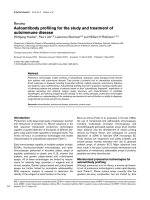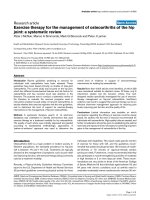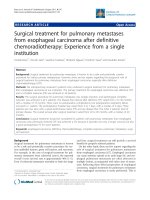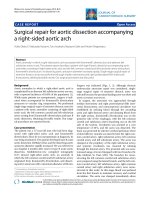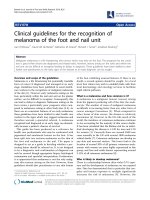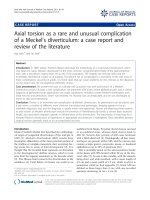Báo cáo y học: "Surgical care for the direct and indirect victims of violence in the eastern Democratic Republic of Congo" pps
Bạn đang xem bản rút gọn của tài liệu. Xem và tải ngay bản đầy đủ của tài liệu tại đây (435.42 KB, 6 trang )
Chu et al. Conflict and Health 2010, 4:6
/>Open Access
RESEARCH
BioMed Central
© 2010 Chu et al; licensee BioMed Central Ltd. This is an Open Access article distributed under the terms of the Creative Commons At-
tribution License ( which permits unrestricted use, distribution, and reproduction in any
medium, provided the original work is properly cited.
Research
Surgical care for the direct and indirect victims of
violence in the eastern Democratic Republic of
Congo
Kathryn Chu*
1,2
, Philippe Havet
3
, Nathan Ford
1,4
and Miguel Trelles
5
Abstract
Background: The provision of surgical assistance in conflict is often associated with care for victims of violence.
However, there is an increasing appreciation that surgical care is needed for non-traumatic morbidities. In this paper
we report on surgical interventions carried out by Médecins sans Frontières in Masisi, North Kivu, Democratic Republic
of Congo to contribute to the scarce evidence base on surgical needs in conflict.
Methods: We analysed data on all surgical interventions done at Masisi district hospital between September 2007 and
December 2009. Types of interventions are described, and logistic regression used to model associations with
violence-related injury.
Results: 2869 operations were performed on 2441 patients. Obstetric emergencies accounted for over half (675, 57%)
of all surgical pathology and infections for another quarter (160, 14%). Trauma-related injuries accounted for only one
quarter (681, 24%) of all interventions; among these, 363 (13%) were violence-related. Male gender (adjusted odds ratio
(AOR) = 20.0, p < 0.001), military status (AOR = 4.1, p < 0.001), and age less than 20 years (AOR = 2.1, p < 0.001) were
associated with violence-related injury. Immediate peri-operative mortality was 0.2%.
Conclusions: In this study, most surgical interventions were unrelated to violent trauma and rather reflected the
general surgical needs of a low-income tropical country. Programs in conflict zones in low-income countries need to
be prepared to treat both the war-wounded and non-trauma related life-threatening surgical needs of the general
population. Given the limited surgical workforce in these areas, training of local staff and task shifting is recommended
to support broad availability of essential surgical care. Further studies into the surgical needs of the population are
warranted, including population-based surveys, to improve program planning and resource allocation and the
effectiveness of the humanitarian response.
Background
The provision of surgical assistance in conflict is often
associated with care for victims of violence. However,
there is an increasing appreciation that surgical care is
needed for non-traumatic morbidities [1]. Armed con-
flict often occurs in low-income countries where fragile
health care systems are rapidly overwhelmed during peri-
ods of violence and associated population displacement.
In such situations, the population becomes even more
vulnerable to threats such as poor hygiene, malnutrition,
infectious diseases, rape, and poor antenatal care [2].
Infections and obstetric emergencies in particular con-
tribute to substantial mortality in these settings and sur-
gical interventions can make an important contribution
to reducing death and disability [3].
An accurate understanding of the surgical needs of
populations in conflict is therefore important for pro-
gram planning and resource allocation. Program audits
for Médecins sans Frontières (MSF) operations during
2008 found that only 30% of surgical interventions were
due to violence-related injuries; the majority of interven-
tions were for obstetric emergencies and accidental
trauma [1]. In this paper we report on surgical interven-
tions carried out by MSF in a zone of active conflict in
* Correspondence:
1
Médecins sans Frontières, 49 Jorrisen St, Braamfontein 2017, Johannesburg,
South Africa
Full list of author information is available at the end of the article
Chu et al. Conflict and Health 2010, 4:6
/>Page 2 of 6
Masisi, North Kivu, Democratic Republic of Congo, and
describe risk factors for violence-related injury.
Methods
Setting
The Democratic Republic of Congo (DRC) is one of the
poorest countries in the world with a per capita GDP of
$300 [4]. North Kivu, located in Eastern DRC, has been
afflicted by conflict since the Rwandan genocide in 1994
which resulted in millions of refugees fleeing into the
region. Its close proximity to Uganda and Rwanda also
make it vulnerable to incursions by armed groups in these
countries. There are various government and rebel fac-
tions, but the main conflict is between the DRC military
and two militia groups, the Hutu-based Democratic
Forces for the Liberation of Rwanda and (the now
defunct) National Congress for the Defense of the People
(CNDP).
MSF has been in North Kivu since 1992, providing
medical services to the displaced and host populations.
The estimated 1.4 million internally displaced persons
who live in North Kivu make up almost half (47%) of the
total population [5]. Life expectancy is 46 years [6] and
leading causes of death are malaria, diarrhea, respiratory
infections, tuberculosis, and neonatal deaths [7]. The ter-
rain is mountainous and poor roads mean the area is only
accessible by all terrain vehicles and motorbikes for most
of the year.
On August 27, 2007, the CNDP attacked the village of
Masisi, located 85 km from Goma, the capital of North
Kivu. Heavy fighting lasted for four days, with small skir-
mishes continuing for several weeks. Tens of thousands of
new IDPs were estimated to have fled the area and while
the number of casualties was not reported, similar waves
of violence in the DRC are known to have resulted in high
civilian mortality [8]. In response, MSF established surgi-
cal services in Masisi district hospital to treat the war
wounded.
Masisi district has 30 primary health clinics, although
many are non-functional due to lack of human resources
or essential supplies. The catchment population is diffi-
cult to establish because of continuous population dis-
placement but is estimated to be around 306,000 people.
Masisi district hospital was established in the late 1960s
as the referral hospital for the district. After the August
2007 attacks in Masisi, the hospital was practically aban-
doned as staff and patients fled to safer areas. Continued
fighting has occurred over the past two years with waves
of increased violence. MSF began the provision of emer-
gency surgical services in September 2007 by renovating
the operating theatre, sterilization unit, and providing
surgeons and anesthesiologists. Surgical care is provided
by an MSF surgeon with the assistance of Congolese gov-
ernment doctors, while anesthestic services are provided
by an MSF anesthesiologist and a Congolese nurse-anes-
thetist. Over time MSF has expanded support to cover all
inpatient services including maternity, pediatrics, and
internal medicine, as well as laboratory services and the
emergency room. Currently there are 32 surgical beds in
the 175-bed hospital. MSF is responsible for all medica-
tion and supplies and provides services free of charge to
patients.
Data Sources
For this analysis, we defined surgical interventions as all
procedures that required anesthesia and were performed
in the operating room. The period of analysis was from
September 2007 to December 2009. The following data
were prospectively collected using Excel: age, gender, mil-
itary status, and American Society of Anesthesiology
(ASA) physical status classification as well as data on sur-
gical pathology, procedure type, blood transfusions, and
operative mortality. Surgical pathology was grouped into
the following categories: obstetric emergencies, infection,
neoplasm, accidental injury, violence-related injury, and
other.
Statistical analysis
Baseline characteristics were described using medians
and interquartile ranges (IQRs) for continuous variables
and counts and percentages for categorical data. Associa-
tions with violence-related injury were explored using
using logistic regression. Variables considered in the
analysis included age, gender, military status, ASA classi-
fication, and blood transfusions. Factors with a p < 0.1 on
univariate analysis were included in a multivariate model.
All tests and confidence intervals were considered to be
significant at a p ≤ 0.05. All analyses were performed
using STATA 10 (College Station, TX, USA).
Results
From September 2007 to December 2009, 2869 opera-
tions were performed on 2441 patients (15% re-interven-
tions). The majority (1855, 76%) were female. Median age
was 24 (interquartile range 18-31); 152 (6%) were under 5
years of age. Sixty-one patients (3%) were in the military.
1263 (44%) procedures were performed under spinal
anesthesia; 1263 (44%) under general anesthesia without
intubation, and only 115 (4%) under general anesthesia
with intubation. Immediate peri-operative mortality was
0.2% (20); however, in-hospital mortality was unknown.
Surgical Pathology
We found that obstetric emergencies accounted for over
half (1463, 51%) of all surgical pathologies, and infections
for another quarter (498, 17%). Trauma-related injuries
accounted for only one quarter (681, 24%) of all interven-
tions; among these, 363 (13%) were violence-related
(Table 1). The proportion of violence-related cases varied
Chu et al. Conflict and Health 2010, 4:6
/>Page 3 of 6
from 0-56%, with peaks occurring during major clashes
(Figure 1). Gunshot wounds accounted for 94% (341) of
violent injuries (Table 2). The most common non vio-
lence-related injuries were burns and falls. The most
common procedure for trauma was wound debridement
while the most common non-trauma-related procedure
was Cesarean section (Table 3).
Associations with violence-related injury
We assessed risk factors for violence-related injury using
a multivariate model that included sex, age, military sta-
tus, ASA classification, and the provision of blood trans-
fusions. Among these, the following were found to be
statistically significantly associated with violence-related
injury: male gender (adjusted odds ratio (AOR) = 19.2, p
< 0.001), military status (AOR = 4.1, p < 0.001), and age
less than 20 years (AOR = 2.1, p < 0.001) (Table 4).
Conclusions
This is among the few studies to describe the typology of
emergency surgical care in a conflict zone. We found that
in this war-ravaged area of Eastern DRC most surgical
interventions were unrelated to violent trauma but rather
reflected the general surgical needs of a low-income trop-
ical country. Most of the emergency procedures per-
formed were similar to those performed in hospitals in
low-income countries not in conflict [9,10]. The preven-
tion of maternal and fetal mortality was the most com-
Figure 1 Surgical procedures for 2008 in Masisi, DRC.
Surgical Procedures for 2008 in Masisi, DRC
0
10
20
30
40
50
60
1 5 10 15 20 25 30 35 40 45 50
Week
% of violence related cases
0
5
10
15
20
25
30
35
Num ber
Percentage of
violence-related
Cases
Total Cases
Major Clashes
Table 1: Types of Surgical Pathology
N(%)
Obstetrical Emergencies 1463 (51)
Infections 498 (17)
Violence-related Injuries 363 (13)
Accidental Injuries 318 (11)
Other* 142 (5)
Neoplasms 82 (3)
2869 (100)
*Congenital, Iatrogenic, Vascular, Other Pathology
Table 2: Causes of Violent Injury
N(%)
Gunshot Wound 341 (94)
Knife 13 (4)
Torture 5 (1)
Rape 3 (1)
Missile 1 (0)
Total 363 (100)
Chu et al. Conflict and Health 2010, 4:6
/>Page 4 of 6
mon reason for emergency surgery in the Masisi
program. Like many populations who suffer a general
lack of access to primary health care, this population suf-
fered from accidents, infections, and late-stage neoplastic
infections.
These findings are consistent with program audits from
other conflict zones in resource-limited settings. A retro-
spective review of surgical services of Médecins Sans
Frontières in six conflict-settings in both Africa (Chad,
Somalia, South Sudan, Democratic Republic of Congo,
and Central African Republic) and South Asia (Pakistan)
found that only 22% of surgical interventions were due to
violent injury, while obstetric emergencies accounted for
almost a third (30%) of interventions and accidental
injury and infections another third [1].
Male soldiers younger than 20 years of age were more
likely to present with violent trauma. While those
patients suffering from violent trauma only accounted for
13% of the surgical cases, they needed special support
such as long-term rehabilitation and psychological coun-
seling. Hospitals in war zones should plan for these
needs.
Our study demonstrated that while this project had
fully trained surgeons and anesthesiologists, most of the
procedures performed were basic. This was in part due to
the limitations of the equipment and the lack of post-
Table 3: Trauma and Non-Trauma Related Interventions
Trauma N (%) Non-Trauma N (%)
Wound Debridement 206 (30) Cesarean section 1304 (60)
Dressing Changes under Sedation 184 (27) Suturing, I and D, Circumcision 237 (11)
Suturing, Incision and Drainage 126 (19) Tubal ligation/Dilation and curretage 113 (5)
Fracture Reductions 64 (9) Dressing Changes under Sedation 112 (5)
Abdominal Surgery/Bowel Resection 21 (3) Abdominal Surgery* 97 (4)
Amputations 20 (3) Wound Debridments 94 (4)
Skin Grafts 17 (2) Minor Surgery** 81 (4)
Other 43 (6) Other 76 (3)
Total 681 (100) Total 2188 (100)
*Bowel resections, appendectomies, removal of tumors
**Herniorraphy, Hydrocele repair, hemmorrhoid surgery
Table 4: Associations with Violence-related Injury
Univariate Multivariate
OR 95% CI P OR 95% CI P
Female 1.0
Male 20.0 (14.0-28.6) <0.001 19.2 (13.1-28.1) <0.001
Age ≥ 20 years 1.0
Age < 20 years 1.4 (1.0-2.0) 0.051 2.1 (1.5-3.0) <0.001
Civillian 1.0
Military 23.4 (13.5-40.6) <0.001 4.1 (2.3-7.4) <0.001
ASA 1-2 1.0
ASA 3-5 2.6 (1.5-4.4) <0.001 1.5 (0.8-2.8) 0.221
No blood transfusion 1.0
Blood transfusion 2.2 (1.0-5.0) 0.063 2.8 (0.9-8.5) 0.068
ASA, American Society of Anesthesiologists physical status classification system
Chu et al. Conflict and Health 2010, 4:6
/>Page 5 of 6
operative intensive care. Also, there was likely to be a
selection bias against complex trauma, as patients with
severe head or chest trauma likely never made it to the
hospital as pre-hospital transport took hours to days.
Nevertheless, this finding is important as it indicates that
most procedures can be performed by general doctors or
non-physician clinicians with surgical skills. For example,
it has been shown that the most common surgical inter-
vention, emergency obstetrical care, can with adequate
training and supervision be performed safely performed
by non-doctors [11-13]. In low-income settings such as
Niger, Malawi, and Mozambique, surgical task-shifting
has resulted in an increased provision in essential surgical
services [14,15]. Similarly, most of these procedures were
safely performed with spinal anesthesia and ketamine
(general anesthesia without intubation) which are safer
types of anesthesia to administer for nurse-anesthetists
or anesthesia providers that are informally trained.
The potential for non-surgeons to manage a substantial
proportion of surgical needs in resource-limited conflict
areas is an important consideration given the lack of local
surgeons in resource-limited settings [16] and the danger
posed to expatriate surgeons (in particular, the higher risk
of kidnapping in certain contexts). In Somalia, where
MSF expatriate surgeons are not allowed due to insecu-
rity, all surgical procedures are performed by non-sur-
geons; operative mortality is <1%. Studies from other
settings demonstrate that the training of general doctors
with surgical skills and nurse anesthetists is possible, even
in a conflict zone [16,17].
This study has certain limitations. The reported num-
bers of war-wounded were often higher than the number
of victims treated at Masisi district hospital, which was
the only health care facility providing surgical care in this
community. While some likely died prior to arriving at
the hospital from severe injuries, others may not have
sought care. This study did not measure reasons for ser-
vice uptake. While all care was free, there may have been
other barriers to accessing care including transportation,
insecurity, and other family responsibilities. Civilians and
soldiers from both sides of the conflict were treated con-
fidentially and respectfully by hospital staff; however,
regional and tribal differences between staff and patients
may have prevented some patients from seeking care.
Special attention to improve access to care for the war-
wounded and IDPs is needed.
Collecting data in conflict settings is challenging, but
not impossible [18]. Our study was limited by our data
collection methods. While our coding system captured
broad categories of surgical pathology, it was limited in
documenting types of operations. The coding system did
not distinguish between some minor surgeries such as
herniorraphy, hydrocele repair, and hemorrhoid surgery
or wound suturing, incision and drainage of abscesses,
and circumcision. Knowing the exact cause of many dis-
eases without radiology or pathology services was also
difficult. We did not have long-term follow-up of patients
nor did we track surgical site infection. While this study
described the burden of essential surgical disease in a
conflict zone, it could not determine the burden of elec-
tive surgical disease. Even though many patients with
elective surgical disease were evaluated at the hospital,
this was unlikely representative of all the type of surgical
disease in the community. Population based studies are
needed to estimate the unmet burden of elective surgical
disease.
In conclusion, programs in conflict zones in low-
income countries need to be prepared to treat both the
war-wounded and non-trauma related life-threatening
surgical needs of the general population. While military
patients have a greater relative risk of violence-related
injuries, civilians still make up the majority of violence-
affected cases in terms of absolute numbers. Training of
local staff and task-shifting is essential to ensure that sur-
gical services will be provided when conditions become
too dangerous for expatriate surgeons to work in the area.
Further studies into the surgical needs of the population
are warranted, including population-based surveys, to
improve program planning and resource allocation and
ultimately the effectiveness of the humanitarian response.
Competing interests
The authors declare that they have no competing interests.
Authors' contributions
KC, NF, and MT were responsible for the overall concept and design. KC and MT
contributed to the data collection and analysis. KC, NF, and MT contributed to
intellectual content, and writing of the paper. KC wrote the first draft of the
paper. All authors reviewed and approved the final version of the paper.
Acknowledgements
The authors would like to thank the MSF field team in Masisi and the staff from
Masisi district hospital for their excellent work and dedication to their patients.
Author Details
1
Médecins sans Frontières, 49 Jorrisen St, Braamfontein 2017, Johannesburg,
South Africa,
2
Departments of Surgery and International Health, Johns Hopkins
University, Baltimore, MD, USA,
3
Médecins sans Frontières, Masisi, Democratic
Republic of Congo,
4
Faculty of Health Sciences, Simon Fraser University,
Vancouver, Canada and
5
Médecins sans Frontières, rue Dupré 94, 1090 Brussels,
Belgium
References
1. Chu K, Trelles M, Ford N: Rethinking surgical care in conflict. Lancet
375:262-263.
2. Sidel VW, Levy BS: The health impact of war. Int J Inj Contr Saf Promot
2008, 15:189-195.
3. Ozgediz D, Riviello R: The "Other" Neglected Diseases in Global Public
Health: Surgical Conditions in Sub-Saharan Africa. PLoS Med 2008,
5:e121.
4. Department US. Background Note: Democratic Republic of the Congo.
[ (accessed 18 March 2010)
5. Wikepedia: North Kivu. [
(accessed 18 March 2010)
Received: 24 February 2010 Accepted: 14 April 2010
Published: 14 April 2010
This article is available from: 2010 Chu et al; licensee BioMed Central Ltd. This is an Open Access article distributed under the terms of the Creative Commons Attribution License ( which permits unrestricted use, distribution, and reproduction in any medium, provided the original work is properly cited.Conflict and Health 2010, 4:6
Chu et al. Conflict and Health 2010, 4:6
/>Page 6 of 6
6. International A: Amnesty International Report 2009 - DR Congo. 2009
[ />congo]. (accessed 18 March 2010)
7. Coghlan B, Ngoy P, Mulumba F, Hardy C, Bemo VN, Stewart T, et al.:
Update on mortality in the Democratic Republic of Congo: results from
a third nationwide survey. Disaster Med Public Health Prep 2009, 3:88-96.
8. Van Herp M, Parqué V, Rackley E, Ford N: Mortality, violence, and lack of
access to health care in the Democratic Republic of Congo. Disasters
2003, 27(2):141-153.
9. Ivers LC, Garfein ES, Augustin J, Raymonville M, Yang AT, Sugarbaker DS,
Farmer PE: Increasing access to surgical services for the poor in rural
Haiti: surgery as a public good for public health. World J Surg 2008,
32:537-542.
10. Ozgediz D, Galukande M, Mabweijano J, Kijjambu S, Mijumbi C, Dubowitz
G, et al.: The neglect of the global surgical workforce: experience and
evidence from Uganda. World J Surg 2008, 32:1208-1215.
11. Bergström S: Enhancing human resources for maternal survival:task
shifting from physicians to non-physicians. 2008 [http://
www.countdown2015mnch.org/documents/presentations/20080418-
bergstrom.pdf]. (accessed 18 March 2010)
12. Chilopora G, Pereira C, Kamwendo F, Chimbiri A, Malunga E, Bergstrom S:
Postoperative outcome of caesarean sections and other major
emergency obstetric surgery by clinical officers and medical officers in
Malawi. Hum Resour Health 2007, 5:17.
13. Pereira C, Cumbi A, Malalane R, Vaz F, McCord C, Bacci A, Bergstrom S:
Meeting the need for emergency obstetric care in Mozambique: work
performance and histories of medical doctors and assistant medical
officers trained for surgery. Bjog 2007, 114:1530-1533.
14. Sani R, Nameoua B, Yahaya A, Hassane I, Adamou R, Hsia RY, et al.: The
impact of launching surgery at the district level in Niger. World J Surg
2009, 33:2063-2068.
15. Mkandawire N, Ngulube C, Lavy C: Orthopaedic clinical officer program
in Malawi: a model for providing orthopaedic care. Clin Orthop Relat Res
2008, 466:2385-2391.
16. Chu K, Rosseel P, Gielis P, Ford N: Surgical task shifting in Sub-Saharan
Africa. PLoS Med 2009, 6(5):1-4.
17. Rosseel P, Trelles M, Guilavogui S, Ford N, Chu K: Ten Years of Experience
Training Non-Physician Anesthesia Providers in Haiti. World J Surg 2009
2010, 34(3):453-8.
18. Ford N, Mills E, Zachariah R, Upshur R: Ethics of research in conflict
settings. Conflict & Health 2009, 3(1):7.
doi: 10.1186/1752-1505-4-6
Cite this article as: Chu et al., Surgical care for the direct and indirect victims
of violence in the eastern Democratic Republic of Congo Conflict and Health
2010, 4:6

